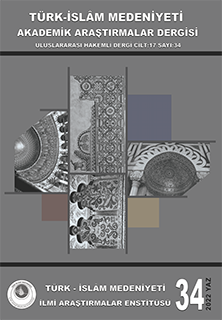Vecd Duygusunun Tasavvufî ve Psikolojik Etkileri
Anahtar Kelimeler:
Vecd, cezbe, müşâhede, âşk, kendini-gerçekleştirme ve kendini-aşma, kişilik bütünlüğü ve kendini keşfetmeÖzet
Tasavvuf kültürü; Allah, kâinat ve insan arasında bir bütünlük kurar. Bu nedenle tasavvuf, âşkın ve bütünlüğün felsefesidir. İnsan, insan-ı kâmil görüşü bağlamında Allah Teâlâ’nın en yüksek derecede muhatabı ve ilahî isim-sıfatların yansımasıdır. Tasavvuf anlayışına göre, yaratılan canlı-cansız, şuurlu-şuursuz her varlık, Allah’ın ilahî isim ve sıfatlarının birer aynası olarak kabul edilir. Yüce isimlerinin yansımalarını kâinatta ve varlıkta gören bir kişi; manevî heyecan, coşku, huzur, ilahî âşk ve iç huzuru duyar. Bu ilahî âşk, heyecan, coşku ve huzur hali içerisinde insanın kendisinden geçmesine ve Rabbini bulma haline, ‘vecd’ denir. Nefsinin sesini duyan kişi, Yüce Allah’a yönelince derin bir coşku veya hüzün hâli yaşamaya başlar. Bunun sonucunda vecd, insanı Allah’ın isim ve sıfatlarıyla bütünlük kurmaya yönlendirir. İlahî âşk, coşku, heyecan ve huzur haliyle kendinden geçerek Rabbini bulma hali olan ‘vecd’ halinin tasavvufî ve psikolojik etkileri bulunmaktadır. Vecd halinin etkisiyle insan; cezbe, müşâhede ve âşkı yaşar. Aynı zamanda insan, vecd halinin etkisiyle kendini-gerçekleştiren, kendini-aşan, kişilik bütünlüğü yakalayan ve kendini keşfeden kişilerin özelliklerini taşımaya başlar.
Referanslar
Akşemseddin, (2007). Makâmatu’l-Evliyâ, İstanbul: Süleymaniye Kütüphanesi, Reşit Efendi Kitaplığı, No: 345, vrk. 181a-b.
Cebecioğlu, E. (2004). Tasavvuf Terimleri ve Deyimleri Sözlüğü. İstanbul: Anka Yayınları.
Cevziyye, İ. K. (1979). Medâricu’s-Salikîn. Beyrût: Dâru’n-Nifâs. Ergül, N. (2015). Tasavvufta Çevre Algısı. The Journal of Academic Social Science Studies, 34(2), 205-216.
Filiz, L. (2013). Noktanın Sonsuzluğu. İstanbul: Pan Kitabevi.
Gilman, L. (1985). Difference and Pathology. New York: Cornell University Press.
Güngör, E. (1982). İslam Tasavvufunun Meseleleri. İstanbul: Ötüken Yayınları.
Hakverdioğlu, M. (2012). Fuzûlî’de Âşk ve Âşık Kavramı, The Journal of Academic Social Science Studies International Journal of Social Science, 5(1), 131155.
Herring, P., O'Connor, P. (1994). The Effects of Self-Discovery. New York: American Psychiatric Association Press.
Hökelekli, H. (2011). Ailede, Okulda, Toplumda Değer Psikolojisi ve Eğitimi. İstanbul: Timaş Yayınları.
Hucvirî. A. B. O. (2006). Keşfü’l-Mahcûb, thk. Mahmûd Âbidî, Tâhran: Intişârât-ı Sâdâ ve Sîmâ.
Kelâbâzî, E. B. M. (1994). Taaruf li Mezhebi Ehli't-Tasavvuf. thk. Ahmed Şemseddin, Beyrût: Dâru'l-Kütübü'l-İlmiyye.
Kula, N. (2000). Sahip Olma ve Emanet Duyguları Açısından İnsan ve Çevre İlişkileri, Çevre ve Din. Uluslararası Çevre ve Din Sempozyumu Bildiri Metinleri, İstanbul.
Kuşeyrî, A. (1993). Risâletu’l-Kuşeyrîyye fi Ilmi’t-Tasavvuf, Beyrût: Dâru’l-Hayr.
Lauster, P. (2000). Âşk ve Aşkın Psikolojisi. (çev. Nurittin Yıldıran). Ankara: Doruk Yayıncılık.
Maslow, A. H. (2001). Maslow's Concept of self Actualization. (translate. Michael Daniels). New York: Liverpool John Moores University Press.
Mcgaughey, W. (2001). Rhythm and Self-Consciousness. Minneapolis: Thistlerose Press.
Meyerovitch, E. D. V. (2004). Duanın Ruhu. (çev. Cemal Aydın). İstanbul: Şûle Yayınları.
Nifferî, A. (1935). The Mawāqif and Mukhātabāt. nşr. Arthur J. Arberry, Messrs Luzac & Co., London.
Rûmî, M. C. (1375). Mesnevi-i Manevî, haz. R.A. Nicholson. Tahrân: Intişârât-ı Hermes. c. 3, b. 1146, 278.
Saruhan, M. S. (2013). İslam Ahlâk Esasları ve Felsefesi. Ankara: Grafiker Yayınları.
Schmahmann, J. (1997). Trandance and Cognition. New York: Academic Press.
Schroeder, L. (1997). The Science of God, New York: Free Press.
Sühreverdî, E. H. Ş. (1966). Avârifü’l-Maârif. Beyrût: Dâru’l-Kitâbi’l-Arabiyyi.
Tûsî, E. N. S. (1960). Luma fi’t-Târihi’t-Tasavvufi’l-İslamiyyi, Kâhire: Dâru’lKütübi’l-Ilmiyyeti.
Uluç, T. (2007). İbn Arabî’de Sembolizm. İstanbul: İnsan Yayınları.
Uludağ, S. (1992). İslâm Açısından Mûsikî ve Semâ. Bursa: Marifet Yayınları.
Uludağ, S. (2003). Meczup, Türkiye Diyanet Vakfı Islam Ansiklopedisi. İstanbul: Türkiye Diyanet Vakfı Yayınları, c. 1-44.
Yılmaz, H. K. (2006). Cezbe, Türkiye Diyanet Vakfı İslam Ansiklopedisi. İstanbul: Türkiye Diyanet Vakfı Yayınları, c. 1-44.
Yılmaz, H. K. (2002). Anahatlarıyla Tasavvuf ve Tarikatlar. İstanbul: Ensar Neşriyat.
İndir
Yayınlanmış
Nasıl Atıf Yapılır
Sayı
Bölüm
Lisans

Bu çalışma Creative Commons Attribution-NonCommercial 4.0 International License ile lisanslanmıştır.







